History
An Eberhardus de Eckebretsteine was first mentioned in the records in a deed of gift by Duke Otto II of Merania in 1248. In 1308, King Henry VII of Germany enfeoffed the brothers Ulrich, Henry and Nickel, of the House of Sack, with the fortress of Epprechtstein; the Wilds were co-owners. In 1337 Emperor Louis IV enfeoffed Vogt Henry of Plauen with a small part of the castle. In 1352, the burgraves of Nuremberg stormed the robber baron castle and were given it as a fief. Amongst the attackers was Henry of Kotzau with his two brothers. In 1355/1356 they purchased the castle, the office and the parish of Kirchenlamitz outright, whereupon Epprechtstein and Kirchenlamitz became part of Sechsämterland ("Six District Land") and the seat of its officials, the Amtmänner . The castle tower was part of the defensive system of the "Wartordnung" of 1498. In the 16th century, the castle was destroyed by troops of Vogt Henry of Plauen and fell into ruin.
The ruins were researched in the 18th century by local historian, Johann Theodor Benjamin Helfrecht, and cartographer, Johann Christoph Stierlein. The artist, Georg Könitzer, sketched a lithograph of the ruins as part of his field of interest around the Fichtel Mountains.

Hof is a town on the banks of the Saale in the northeastern corner of the German state of Bavaria, in the Franconian region, at the Czech border and the forested Fichtel Mountains and Franconian Forest upland regions. The town has 47,296 inhabitants, the surrounding district an additional 95,000.

Bad Berneck im Fichtelgebirge is a spa town in the district of Bayreuth, in Bavaria, Germany. It is situated on the White Main river, in the Fichtel Mountains, 13 km northeast of Bayreuth. It lies in the northern part of the Bavarian province of Upper Franconia. Since 1857 it has been a spa, initially based on its climate and whey products. In 1930 it became a Kneipp spa and, in 1950, a Kneipp health spa.

Waldeck Castle within the limits of the village of Dorweiler in Dommershausen in the Rhein-Hunsrück-Kreis (district) in Rhineland-Palatinate was the main seat of the Hunsrück family of Boos.
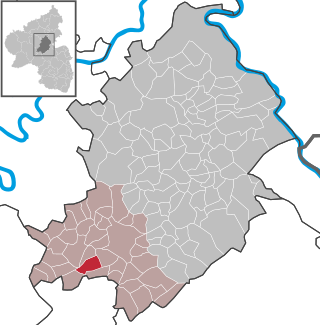
Dill is an Ortsgemeinde – a municipality belonging to a Verbandsgemeinde, a kind of collective municipality – in the Rhein-Hunsrück-Kreis (district) in Rhineland-Palatinate, Germany. It belongs to the Verbandsgemeinde of Kirchberg, whose seat is in the like-named town, and it is home to a castle ruin that bears the same name.

Rheinstein Castle is a castle near the town of Trechtingshausen in Rhineland-Palatinate, Germany.

Finkenstein Castle is a ruined medieval castle in the market town of Finkenstein, in the Austrian state of Carinthia. It is situated on a steep cliff at the southern foot of the Karawanks mountain range, high above Lake Faak, at a height of 788 metres (2,585 ft). Today the castle ruin is the backdrop of the Burgarena, an amphitheatre with 1150 seats mainly used for concerts and festivals.

The Waldsteinburg, also called the Red Castle is a ruined castle on the summit of the Großer Waldstein in the Fichtel Mountains of Germany. It is also known as the Westburg to distinguish it from the older ruins of the Ostburg.

With its 827-metre-high (2,713 ft) peak the Große Kornberg is the northeast cornerstone of the Fichtel Mountains in south Germany. It forms a wooded ridge, which is recognisable from a long distance by its former military surveillance tower It is also the local 'house' mountain of Schönwald and Schwarzenbach an der Saale.
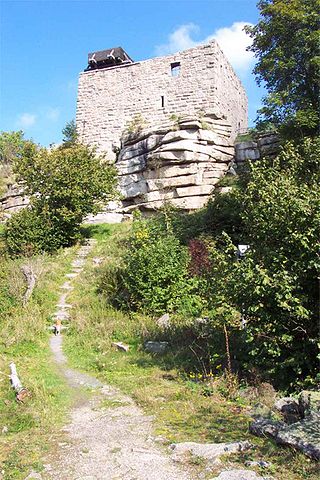
The Epprechtstein is a mountain in the northern Fichtel Mountains in northeast Bavaria, Germany, 798 m above sea level (NN). It is mineralogically the most interesting mountain in the entire Fichtel range. Around the summit there are about 20 quarries, in three of which Epprechtstein granite is quarried. The others are closed and partially overgrown.

Münzenberg Castle is a ruined hill castle in the town of the same name in the Wetteraukreis, Hesse, Germany. It dates from the 12th century. It is one of the best preserved castles from the High Middle Ages in Germany.
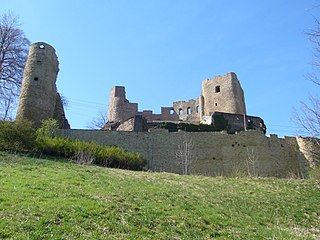
The ruins of Frauenstein Castle are located on a 680 metres (2,230 ft) high granite rock on the crest of the Eastern Ore Mountains near the town of Frauenstein in the district of Mittelsachsen.

The House of Wild was a Saxon noble family that also lived in parts of Franconia, southern Germany.

The ruins of Alt-Trauchburg Castle, also called the Alttrauchburg or Trauchburg, lie above the Weitnau hamlet of Kleinweiler in the county of Oberallgäu in Swabia. Large parts of the original stone walls of the high- to post-medieval castle remain. The ruins are some of the best preserved in the Allgäu region of Germany.
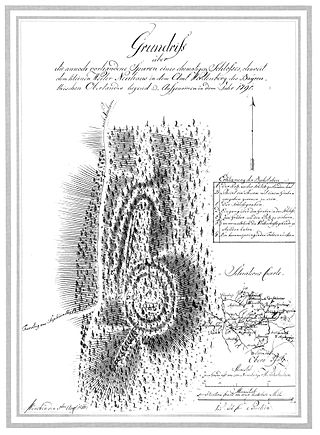
The Burgstall of Schlosshügel near Weidenberg is a lost hill castle or circular rampart site of the type known as a motte from the Early Middle Ages. It lies on the southern perimeter of the Fichtel Mountains at a height of 699 metres above sea level (NN) above the village of Sophienthal, which is part of the market borough of Weidenberg in the Upper Franconia county of Bayreuth in Bavaria. The burgstall or lost castle site was partly investigated by means of an archaeological test excavation and was also mapped several times in the past.

Mildenstein Castle, in German Burg Mildenstein, also called Schloss Leisnig, is located in Leisnig in Landkreis Mittelsachsen, Saxony, Germany. It is a property of the Free State of Saxony and is administrated by the company State Palaces, Castles and Gardens of Saxony.

Rabeneck Castle is a former high mediaeval aristocratic castle which stands high above the valley of the Wiesent in the Upper Franconian district of Bayreuth in the German state of Bavaria.
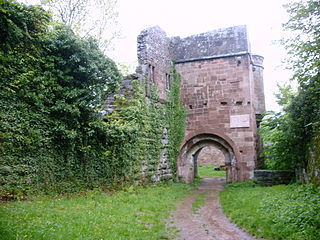
Wildenberg Castle, also called the Wildenburg, is a ruined, Hohenstaufen period castle in the Odenwald hills in Germany. It is located in the parish of Preunschen in the municipality of Kirchzell, in the Lower Franconian district of Miltenberg in Bavaria.
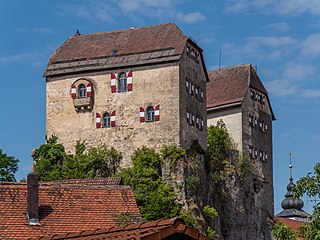
Hiltpoltstein Castle was originally a high mediaeval aristocratic castle dating to the 11th or 12th century. It stands in the centre of the market village of Markt Hiltpoltstein in the Upper Franconian county of Forchheim in the south German state of Bavaria. Its present appearance as a triple-winged building goes back to renovations carried out at the end of the 16th century.

The ruins of Ramstein Castle stand on a 182-metre-high, Bunter sandstone rock on the edge of the Meulenwald forest in the lower, steep-sided Kyll valley near Kordel in the German state of Rhineland-Palatinate. It stands 9 kilometres (5.6 mi) north of Trier and the same east of Luxembourg.

Wernerseck Castle, also called the Kelterhausburg, is a late medieval hill castle in the municipality of Ochtendung in the county of Mayen-Koblenz in the German state of Rhineland-Palatinate. It owes its name to its founder and lord of the castle, the Archbishop of Trier, Werner of Falkenstein (1388–1418). "Wernerseck" means "Werner's corner".























